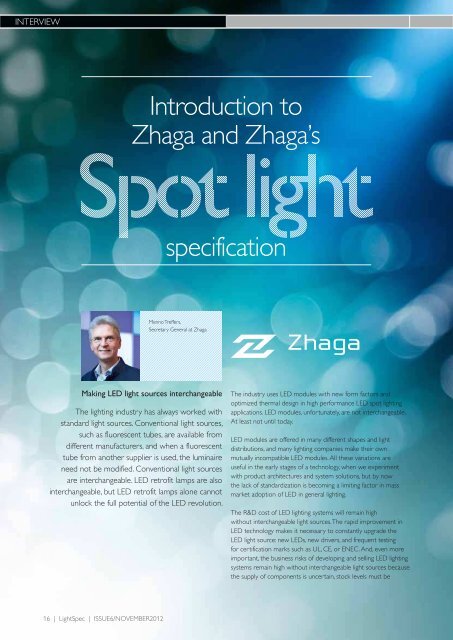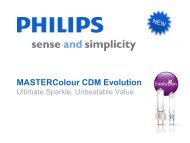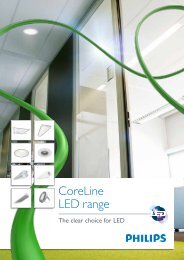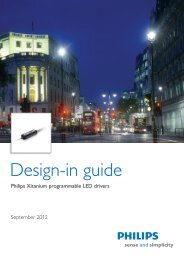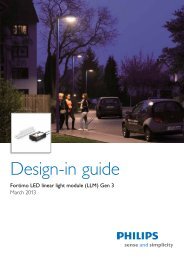Quality of light and the - Philips Lighting
Quality of light and the - Philips Lighting
Quality of light and the - Philips Lighting
Create successful ePaper yourself
Turn your PDF publications into a flip-book with our unique Google optimized e-Paper software.
iNtERViEW<br />
Menno treffers,<br />
secretary General at Zhaga<br />
Making LED <strong>light</strong> sources interchangeable<br />
<strong>the</strong> <strong>light</strong>ing industry has always worked with<br />
st<strong>and</strong>ard <strong>light</strong> sources. Conventional <strong>light</strong> sources,<br />
such as fluorescent tubes, are available from<br />
different manufacturers, <strong>and</strong> when a fluorescent<br />
tube from ano<strong>the</strong>r supplier is used, <strong>the</strong> luminaire<br />
need not be modified. Conventional <strong>light</strong> sources<br />
are interchangeable. LED retr<strong>of</strong>it lamps are also<br />
interchangeable, but LED retr<strong>of</strong>it lamps alone cannot<br />
unlock <strong>the</strong> full potential <strong>of</strong> <strong>the</strong> LED revolution.<br />
16 | Lightspec | issuE6/NoVEMBER2012<br />
introduction to<br />
Zhaga <strong>and</strong> Zhaga’s<br />
specification<br />
<strong>the</strong> industry uses LED modules with new form factors <strong>and</strong><br />
optimized <strong>the</strong>rmal design in high performance LED spot <strong>light</strong>ing<br />
applications. LED modules, unfortunately, are not interchangeable.<br />
at least not until today.<br />
LED modules are <strong>of</strong>fered in many different shapes <strong>and</strong> <strong>light</strong><br />
distributions, <strong>and</strong> many <strong>light</strong>ing companies make <strong>the</strong>ir own<br />
mutually incompatible LED modules. all <strong>the</strong>se variations are<br />
useful in <strong>the</strong> early stages <strong>of</strong> a technology, when we experiment<br />
with product architectures <strong>and</strong> system solutions, but by now<br />
<strong>the</strong> lack <strong>of</strong> st<strong>and</strong>ardization is becoming a limiting factor in mass<br />
market adoption <strong>of</strong> LED in general <strong>light</strong>ing.<br />
<strong>the</strong> R&D cost <strong>of</strong> LED <strong>light</strong>ing systems will remain high<br />
without interchangeable <strong>light</strong> sources. <strong>the</strong> rapid improvement in<br />
LED technology makes it necessary to constantly upgrade <strong>the</strong><br />
LED <strong>light</strong> source: new LEDs, new drivers, <strong>and</strong> frequent testing<br />
for certification marks such as uL, CE, or ENEC. <strong>and</strong>, even more<br />
important, <strong>the</strong> business risks <strong>of</strong> developing <strong>and</strong> selling LED <strong>light</strong>ing<br />
systems remain high without interchangeable <strong>light</strong> sources because<br />
<strong>the</strong> supply <strong>of</strong> components is uncertain, stock levels must be<br />
high to hedge that uncertainty, <strong>and</strong> <strong>the</strong> risk <strong>of</strong> obsolescence <strong>and</strong><br />
write<strong>of</strong>fs is high. <strong>the</strong> Zhaga Consortium was established with <strong>the</strong><br />
goal to make LED <strong>light</strong> sources interchangeable. this will benefit<br />
luminaire manufacturers because it lowers <strong>the</strong>ir R&D costs <strong>and</strong><br />
business risks, <strong>and</strong> it benefits <strong>the</strong> manufactures <strong>of</strong> LED modules<br />
because <strong>the</strong>y can supply a larger <strong>and</strong> faster growing market with<br />
lower selling expenses <strong>and</strong> reduced risk <strong>of</strong> obsolescence.<br />
// What is an interchangeable <strong>light</strong> source?<br />
in this context we consider two <strong>light</strong> sources interchangeable<br />
when one <strong>light</strong> source can replace <strong>the</strong> o<strong>the</strong>r <strong>light</strong> source without<br />
any change in <strong>the</strong> luminaire. We are not only talking about enduser<br />
replaceable <strong>light</strong> sources, but also about LED modules (PCBs)<br />
that are integrated into <strong>the</strong> luminaire <strong>and</strong> can be sealed for life. in<br />
<strong>the</strong> latter case, interchangeability means that <strong>the</strong> manufacturer can<br />
switch from one supplier to ano<strong>the</strong>r without modification in <strong>the</strong><br />
manufacturing process <strong>of</strong> <strong>the</strong> luminaire.<br />
in Zhaga we use <strong>the</strong> term ‘LED <strong>light</strong> engine’ when we talk about<br />
interchangeable <strong>light</strong> sources. We use this term to identify <strong>the</strong><br />
combination <strong>of</strong> an LED module <strong>and</strong> its associated current source.<br />
as with many conventional <strong>light</strong> sources, <strong>the</strong> LED <strong>light</strong> engine is<br />
not necessarily integrated in a single housing: <strong>the</strong> driver or ECG<br />
that supplies a stable current to <strong>the</strong> LEDs may be separate from<br />
<strong>the</strong> LED module from which <strong>the</strong> <strong>light</strong> is emitted.<br />
to achieve interchangeability, <strong>the</strong> luminaire must ‘know’<br />
what to expect from an LED <strong>light</strong> engine:<br />
1. <strong>the</strong> maximum size (<strong>the</strong> mechanical outline).<br />
2. <strong>the</strong> fixation method (e.g. screws at fixed positions,<br />
or a holder).<br />
3. <strong>the</strong> amount <strong>of</strong> heat generated by <strong>the</strong> LED <strong>light</strong> engine<br />
as well as <strong>the</strong> maximum operating temperature.<br />
4. <strong>the</strong> location <strong>and</strong> size <strong>of</strong> <strong>the</strong> <strong>light</strong> emitting surface, in relation<br />
to <strong>the</strong> luminaire’s reflector.<br />
5. <strong>the</strong> distribution, uniformity, <strong>and</strong> o<strong>the</strong>r photometric properties<br />
<strong>of</strong> <strong>the</strong> <strong>light</strong> emitted by <strong>the</strong> LED <strong>light</strong> engine.<br />
6. <strong>the</strong> electrical characteristics (e.g. mains voltage<br />
requirements, control methods).<br />
Note that ‘interchangeable’ does not imply ‘identical’.<br />
‘interchangeable’ means that <strong>the</strong> differences are acceptable in <strong>the</strong><br />
context <strong>of</strong> a particular <strong>light</strong>ing application. it is not necessary that<br />
<strong>light</strong> engines are identical. if we ask that <strong>light</strong> sources become<br />
identical it would limit innovation, it would limit <strong>the</strong> possibility to<br />
differentiate <strong>light</strong>ing products, <strong>and</strong> it would make it more difficult<br />
to target applications with special requirements.<br />
// What is an interface specification?<br />
Zhaga specifies <strong>the</strong> interface between an LED luminaire <strong>and</strong> an<br />
LED <strong>light</strong> engine. a good interface specification defines only <strong>the</strong><br />
interaction between luminaire <strong>and</strong> <strong>light</strong> engine. it should not<br />
unnecessarily restrict <strong>the</strong> design <strong>of</strong> <strong>the</strong> <strong>light</strong> engine, or <strong>the</strong> design<br />
<strong>of</strong> <strong>the</strong> luminaire. a good interface specification allows innovation<br />
inside <strong>the</strong> <strong>light</strong> engine while keeping <strong>the</strong> interaction with <strong>the</strong><br />
luminaire stable.<br />
Mechanical<br />
interface<br />
Thermal<br />
interface<br />
LED <strong>light</strong> engine<br />
Photometrical interface<br />
Electrical<br />
interface<br />
Zhaga specifications define <strong>the</strong> interaction between <strong>light</strong> source <strong>and</strong> luminaire without<br />
restricting innovation in <strong>the</strong> technology inside <strong>the</strong> <strong>light</strong> engine.<br />
Zhaga specifications have requirements for products on both<br />
sides <strong>of</strong> <strong>the</strong> interface: <strong>the</strong> LED luminaire has to provide <strong>the</strong><br />
proper environment for <strong>the</strong> LED <strong>light</strong> engine, <strong>and</strong> <strong>the</strong> <strong>light</strong> engine<br />
has to fit inside <strong>the</strong> luminaire. Zhaga specifications describe test<br />
procedures for luminaires <strong>and</strong> test procedures for <strong>light</strong> engines.<br />
<strong>the</strong>se test procedure help <strong>the</strong> product developer to determine<br />
whe<strong>the</strong>r <strong>the</strong>ir product complies with all <strong>the</strong> Zhaga requirements.<br />
<strong>the</strong> test procedures are meant to be complete <strong>and</strong> sufficient.<br />
ideally, an LED <strong>light</strong> engine that passed all tests will fit in all<br />
luminaires that passed <strong>the</strong> tests, <strong>and</strong> <strong>the</strong> behavior <strong>of</strong> <strong>the</strong> <strong>light</strong>ing<br />
system (<strong>the</strong> combination <strong>of</strong> luminaire <strong>and</strong> <strong>light</strong> engine) is fully<br />
predictable. in practice it is difficult to specify <strong>the</strong> test procedures<br />
100% complete. <strong>the</strong> Zhaga members deal with this challenge<br />
by building prototypes <strong>and</strong> testing <strong>the</strong>m before <strong>the</strong> specification<br />
is released. that way it is possible to identify ambiguities <strong>and</strong><br />
inconsistencies, <strong>and</strong> revise <strong>and</strong> improve <strong>the</strong> specifications. By <strong>the</strong><br />
time <strong>the</strong> first products arrive in <strong>the</strong> market <strong>the</strong> test specifications<br />
are mature <strong>and</strong> give sufficient coverage.<br />
// Book 1 – a special specification<br />
several test procedures <strong>and</strong> aspects <strong>of</strong> <strong>the</strong><br />
Book 3 specification are not unique to Book 3.<br />
<strong>the</strong> <strong>the</strong>rmal test methods, for example, apply<br />
equally well to Zhaga’s Book 2, Book 3, Book 4,<br />
Impression <strong>of</strong> a<br />
Zhaga spot <strong>light</strong><br />
engine.<br />
www.philips.com/<strong>light</strong>spec<br />
<strong>and</strong> Book 5, <strong>and</strong> Book 6. <strong>and</strong> <strong>the</strong> mechanical<br />
dimensions <strong>of</strong> ECG housings apply to all Zhaga<br />
<strong>light</strong> engines that have a separate Electronic<br />
Control Gear.<br />
<strong>the</strong> Zhaga members have collected <strong>the</strong>se common specifications<br />
in Book 1 “overview <strong>and</strong> Common information”. Whereas this<br />
book does not specify a <strong>light</strong> engine <strong>and</strong> you will find that <strong>the</strong><br />
o<strong>the</strong>r Zhaga books reference Book 1 quite <strong>of</strong>ten.<br />
issuE6/NoVEMBER2012 | Lightspec | 17


